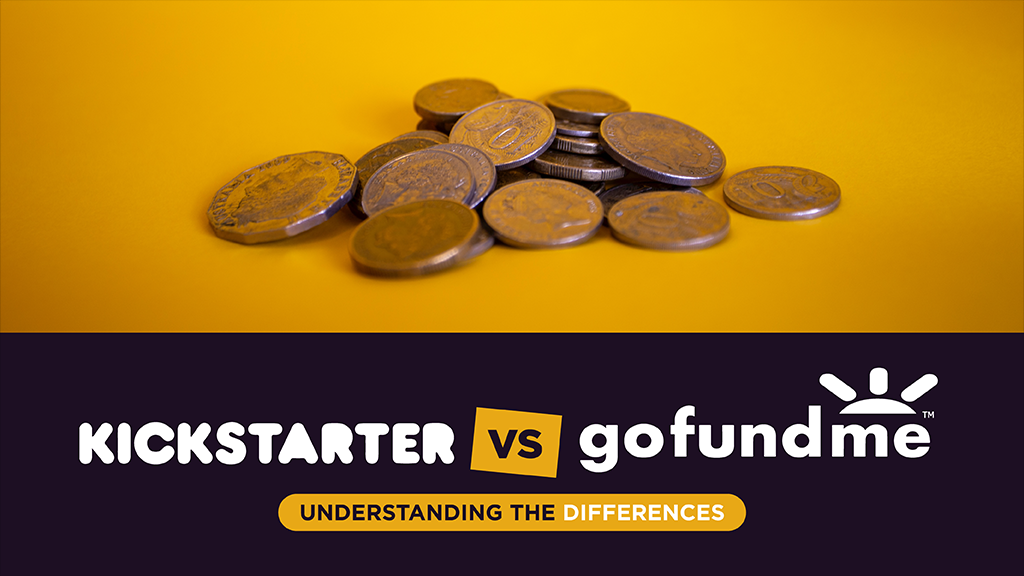
Crowdfunding has become the go-to method for entrepreneurs looking for alternatives to the traditional way of raising funds. As of July 2023, $34 billion has been raised globally through crowdfunding.
This demand has resulted in the rise of crowdfunding platforms. As of 2021, the United States alone had 1,478 crowdfunding organizations.
Two among these stand out as some of the most popular platforms: Kickstarter and GoFundMe. While both have provent to be effective, these two platforms serve different industries.
So, if you want to crowdfund, which platform should you use?
To help you decide, we’ll explore the following areas to provide a comprehensive understanding of each platform:
-
- Target Industries – Which platform best suits your project’s specific industry and audience?
- Platform Rules – The rules and regulations governing fundraising on each platform.
- Web Traffic – The level of web traffic and exposure each platform offers.
Processing and Platform Fees
-
- Funding Models – Understand the different funding models employed by Kickstarter and GoFundMe and choose the one that aligns with your campaign’s requirements.
- Rewards and Pledges – Learn how these two platforms let you structure rewards and pledges to entice backers and maximize your campaign’s success.
- Backer Updates – The methods and tools available to keep your backers informed and engaged throughout the campaign.
- Customer Support – The level of customer support each platform provides and the assistance available to campaign creators.
- Extra Features – Additional features and functionalities that set each platform apart from the other.
Pros and Cons
But first, before we dive into each section, here’s a comparison table to show you the key differences between Kickstarter and GoFundMe.
| Criteria | Kickstarter | GoFundMe |
| Best Suited For | Creative projects, art, music, film, technology | Personal fundraising, charitable causes |
| Funding Model | All-or-nothing | Keep all funds raised, regardless of the goal |
| Processing Fees | 3% + $0.20 per pledge | 2.9% + $0.30 per pledge |
| Platform Fees | Additional 5% | None |
| Pros |
|
|
| Cons |
|
|
Contents
Target industries
One thing to know about crowdfunding is that different platforms have their strengths and are better suited for specific industries or project types.
Kickstarter has a focus on creativity and innovation. It’s well-suited for projects in the art, music, film, and technology industries. The community of backers on Kickstarter is passionate about supporting creative ventures.

For example, if you have a project, such as developing a new board game or creating a video game, you can tap into the platform’s dedicated gaming community. The Gaming category on Kickstarter has raised a whopping $2.23 billion.
GoFundMe, on the other hand, is more versatile and caters to a wide range of industries and project types. However, it’s popular for personal fundraising and charitable causes.
Most likely, you have encountered those projects on medical expenses, disaster relief, community initiatives, or any other cause-related project. Most of these are found on GoFundMe.
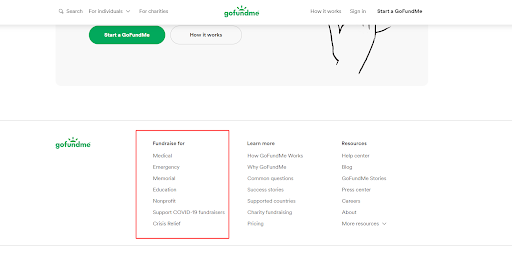
Since 2010, $15 billion has been raised on GoFundMe from more than 120 million donations.
One success story on GoFundMe is the Club Q Victims campaign. The creator, Faith Haugh, set to raise $5,000 for the shooting victims at Club Q, an LGBTQ club in Colorado Springs.
In two hours, the campaign had raised five times more. She increased the goal of the campaign to $1 million. The campaign closed, having raised $934,420.
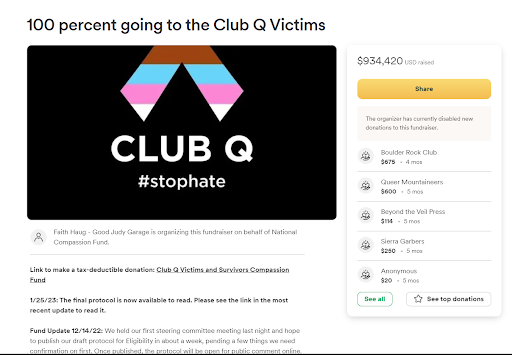
So, go for Kickstarter if:
- Your project falls within the creative industries such as art, music, film, or technology.
- You are seeking funding for an innovative product, creative endeavor, or artistic project.
- You want to tap into a community of backers who appreciate and support creative ventures.
On the other hand, go for GoFundMe if:
- Your project involves personal fundraising or charitable causes.
- You need to raise funds for medical expenses, disaster relief, community initiatives, or similar cause-related projects.
- You want to engage with a versatile platform that caters to a wide range of industries and project types.
Platform rules
The platform rules and guidelines govern how campaigns are created, promoted, and managed on each platform.
Kickstarter has a set of fairly strict rules and guidelines, both for the types of projects that can be launched and how they’re run.
Only projects that fall within their defined categories are allowed. Charity or cause-based funding is not permitted.
Two, every Kickstarter project must have a clear goal and must produce something tangible. This can be anything from a book or film to a piece of technology or a game.
In addition, the platform demands transparency, particularly when it comes to the development status of a product.
If a project involves creating a physical product, you’re required to show a prototype, and this demonstration should reflect the product’s current state. Using overly enhanced demonstrations or computer-generated images (CGI) to represent the final product is not permitted.
Also, one of the critical distinctions is that projects can’t offer equity. Unlike equity crowdfunding platforms, where backers become investors and receive a stake in the company, Kickstarter operates on a reward-based model.
Finally, Kickstarter lists prohibited items that can’t be included in projects. These include drugs, weapons, alcohol, and other illegal items.
GoFundMe’s platform rules emphasize honesty, transparency, and the legal use of funds. Since this platform is often used to fund personal needs, medical expenses, education costs, or philanthropic causes, maintaining trust with donors is critical.
The campaigns created on GoFundMe shouldn’t be misleading or fraudulent. You’re required to provide complete, accurate, and honest information about the cause and the purpose of the funds you’re raising. This includes details about:
- Who you are
- Who the beneficiary of the funds is
- How will you use the funds
- If you have any business or personal relationship with the beneficiary
Also, sales are prohibited on the GoFundMe platform. You’re not allowed to offer goods in exchange for donations on the platform.
NOTE: GoFundMe campaigns are usually giveaway incentives-based, so there’s no obligation for campaign organizers to provide rewards or returns to the donors, unlike Kickstarter. All giveaways are considered gifts and not investments, so donors can’t claim any tax benefits or returns on their contributions.
Funding models
Kickstarter operates on an “all-or-nothing” funding model.
This means that if you don’t meet your funding goal within the campaign period, you receive no money, and the backers are not charged for their pledges.
Experts have found this approach to be beneficial. It increases the sense of urgency and encourages backers to share the project with others.
It also protects backers because they know their money will only be used if the project reaches its goal.
However, it puts more pressure on the project creators to set realistic goals and effectively promote their projects. This pressure reflects in the numbers, as Kickstarter has a 40.62% success rate.
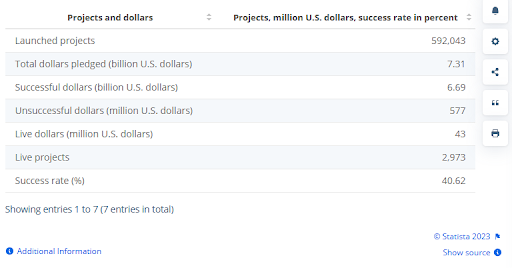
GoFundMe employs a “keep-it-all” model. You receive any funds raised, whether or not you meet your funding goal.
This model is suitable for personal causes or charitable campaigns where any amount of funding can help.
However, it can potentially lead to a situation where you receive funds but not enough to achieve the intended purpose. Now the backers will expect results that you might struggle to fulfill.
In these cases, communicate clearly with the donors about how the funds will be used.
The “all-or-nothing” model is often better for projects that require a minimum amount of funding to be viable, while the “keep-it-all” model is more suited to causes where any amount of funding can make a difference.
Rewards and pledges
Rewards and pledges are another area where Kickstarter and GoFundMe diverge significantly. It reflects their differing orientations toward project-based and cause-based fundraising.
Kickstarter defines rewards as “items created as a result of running a successful Kickstarter project (a copy of the album, a print from the collection) or more experiential rewards (visits to the set, a private cooking class).”
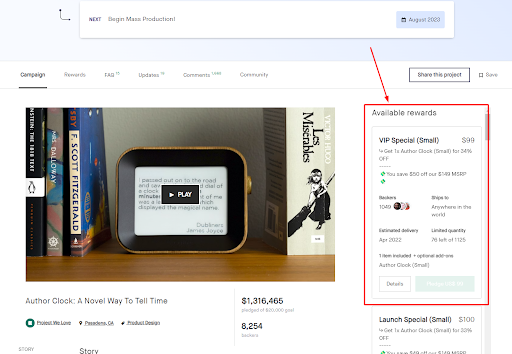
On Kickstarter, rewards should align with the maximum pledge value allowed for your project’s location. For example, the maximum amount you can set a reward tier value for US-based projects is $10,000, while for UK-based projects, it’s £8,000.
These limits ensure that rewards remain feasible and that project creators don’t overextend themselves.
Kickstarter also offers the feature of “add-ons.” These are optional rewards that backers can select in addition to their main reward. We recommend offering add-ons directly related to the project or items you already have in inventory.
Remember to only commit to what you can successfully deliver.
Because if a project is successfully funded, you are legally obliged to fulfill the promised rewards or refund any backers whose reward you cannot fulfill.
GoFundMe, by contrast, doesn’t operate on a rewards system. As it’s primarily used for personal and charitable causes, backers make donations, not pledges towards rewards.
Backers contribute because they believe in the cause and want to help rather than to receive a product or service in return.
That said, some campaign organizers offer updates or small tokens of appreciation to donors, but this is not a requirement or an integral part of the GoFundMe model.
Some of the ways to say thank you to your donors on GoFundMe include:
- Sending thank you emails
- Giving the donors a shout on social media
- Sending them a creative gift or a postcard
- Send them a handwritten thank you note
Processing and platform fees
The processing and platform fees for Kickstarter and GoFundMe are other important factors to consider when choosing between the two.
These fees take a chunk of the money you receive. So you need to be aware of them when calculating your budget.
Kickstarter charges a platform fee of 5% of the total funds raised if a project is successful. This fee covers the cost of running the platform, including providing support for its services.
You don’t pay any fees if the project is unsuccessful (it doesn’t reach its initial funding goal).
In addition, there are Stripe payment processing fees that typically range from 3% to 5% per pledge, depending on the country of the creator.
These fees go directly to the payment processor and are separate from Kickstarter’s platform fees.
GoFundMe, on the other hand, no longer charges a platform fee for individual and business campaigns in many countries.
Instead, they ask for optional donations from donors to help run the platform.
However, a standard payment processing fee of 2.9% plus $0.30 per donation is charged to cover the cost of processing each donation. It helps in the following:
- Costs of credit and debit charges
- Cost of safely delivering the donations
- Lets GoFundMe diverse the payment methods
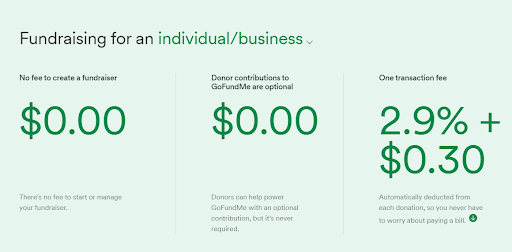
For GoFundMe, each donation is processed, and the fee is deducted immediately. You receive the donation minus the processing fee.
NOTE: GoFundMe charges transaction fees whether your campaign reaches its funding goal or not.
Ensure you factor these fees into your fundraising goal to ensure that you raise enough funds to cover the costs of your project after fees are deducted.
Updating the backers and donors
Regular updates foster a sense of community, maintain engagement, and ensure transparency about how funds are being used.
On Kickstarter, you can post updates to your campaign page anytime.
You can post text-only updates or enrich your posts with images, videos, and sound clips for a more interactive experience. Depending on the nature of the information, you can make the updates public or exclusively for backers.
You can email updates to all your backers or just to backers of specific reward tiers.
Kickstarter offers an interesting feature. After you post an update, you get a 30-minute window to review the update and make any necessary edits.
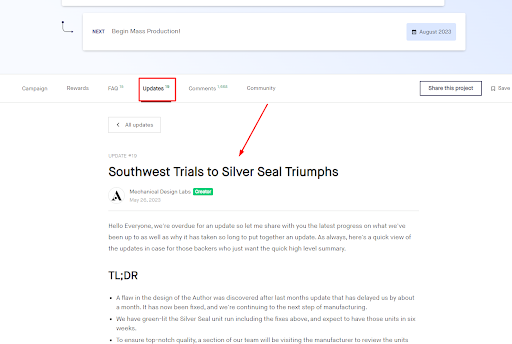
Similarly, GoFundMe encourages campaign organizers to post updates regularly.
“Aim to update your donors at least once a week.”
—GoFundMe
Updates on GoFundMe often include progress towards the fundraising goal, how funds have been or will be used, and any news or developments related to the cause.
Like Kickstarter, you can send out these to all donors and share them publicly on the campaign page.
“When you reach 25% of your fundraising goal: Keep up the momentum by posting an update and letting people know how new donations can help.”
—GoFundMe
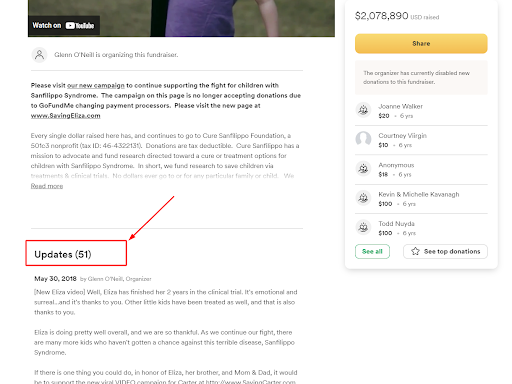
Remember, backers value regular, insightful, and honest updates. Don’t hesitate to communicate any delays or changes to your initial plans or simply check-in.
Customer support
Kickstarter provides a comprehensive Help Center that includes articles on various topics, from starting a project to troubleshooting technical issues.
They also have a Common Account Issues page where you can search for troubleshooting information.
If further help is required, you can submit a request to Kickstarter’s support team through an online form. If you’re a creator, you need to be logged in. However, you can also contact Kickstarter “as a guest.”
GoFundMe, similarly, has a team ready to address your questions promptly and help you resolve any issues via their Help Center, email, or live chat.
For example, if you suspect fraudulent activity related to a fundraiser, you can report it directly to GoFundMe’s Trust and Safety team.
Note, avoid reporting your fundraiser in an attempt to contact the support team. Instead, if you need to contact the support team, click on the “Get help” button on each Help Center article. There, you’ll encounter their HelperBot, Ray, designed to provide immediate assistance or guide you toward relevant information.’
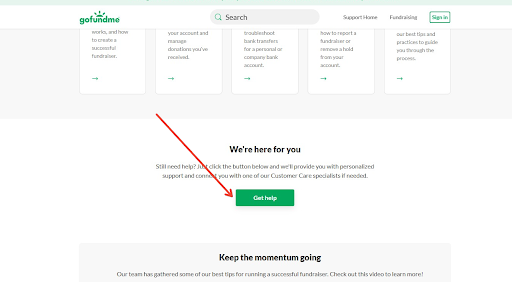
If Ray doesn’t address your issue, it will gather your information and connect you with the team via chat or email.
When contacting the support team, remember to provide the exact email address used to create your GoFundMe account or make a donation.
Extra features
Each crowdfunding platform, Kickstarter and GoFundMe, offers additional features that enhance the user experience. These could potentially influence your decision when selecting a platform.
Integrations
GoFundMe edges out Kickstarter when it comes to the number of integrations. GoFundMe integrates with tools such as:
- Salesforce Sales Cloud
- Google Analytics 360
- Blackbaud Raiser’s Edge NXT
You can see the whole list here.
Kickstarter has only one notable integration, Synthesia. With Synthesia, you can make your Kickstarter project video stand out.
Analytics
When crowdfunding, you need to consider the power of analytics. These provide data that can significantly influence the direction and success of your crowdfunding campaign.
Understanding who your backers are, where they are coming from, and how they interact with your campaign page helps you tailor your communication and adjust your marketing strategies.
In 2011, Kickstarter introduced the Project Dashboard for Creators feature. Here, you can see the following metrics:
- Overall funding graph
- Average pledge amount
- Video play statistics
- Reward popularity
- The source of backers
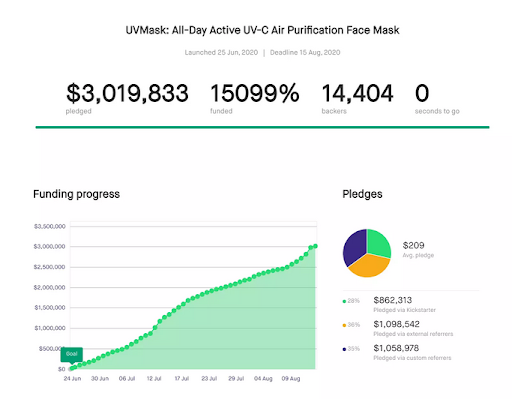
GoFundMe also offers a campaign management dashboard to view the number of shares your campaign has received on social media, the total number of donors, and the average donation amount.
Furthermore, you can track the specific individuals who have donated to your campaign. This provides an opportunity for personalized thank-you messages and relationship building.
However, GoFundMe’s analytics features are somewhat less extensive than Kickstarter’s.
GoFundMe Donate Button for Individuals
The GoFundMe Donate Button is a custom widget you integrate into your website or blog.
This widget displays your fundraising campaign, including the primary campaign image, the title, and the amount raised so far.
The Button is not just a tool for collecting donations — it also serves to spread awareness about your cause.
To incorporate the GoFundMe Donate Button into your online platforms, follow these simple steps:
- Start or identify a fundraiser – Initiate a new one or identify an existing one you wish to promote with the Donate Button.
- Generate and copy the embed code – On the page of the chosen fundraiser, click on the “Share” button. From the options that appear, select “Embed,” and this will generate an HTML code. Copy this code.
- Implement the embed code – Once you have the HTML code, navigate to your website or blog. Utilize the editing feature of your platform to paste the HTML code into the desired page. Once implemented, the GoFundMe Donate Button will be visible on your site.
Campaign extension
Both Kickstarter and GoFundMe have policies around campaign extension.
Kickstarter operates on a fixed funding model and allows crowdfunding campaigns to run anywhere from one to 60 days.
However, Kickstarter recommends that campaigns run for 30 days or less for the highest chance of success.
- Shorter campaigns create a sense of urgency.
- Most Kickstarter campaigns see the highest levels of activity at the beginning and end of the campaign. Mid-campaign often sees a lull in new pledges. A shorter campaign minimizes this lull and helps maintain excitement and momentum.
- Running a crowdfunding campaign requires effort, including promotion, updates, and communication with backers – A shorter campaign is less draining.
- A shorter timeline encourages better planning and execution.
Now, you can’t extend a Kickstarter campaign beyond 60 days. Let’s say you had set the campaign period to be 30 days. You can request an extension during the final week of your campaign. However, such extensions are subject to certain conditions and are not automatically granted.
You have to submit this request for an extension when 7 days or fewer remain in the campaign. Note this extension can’t exceed the platform’s maximum campaign duration limit of 60 days.
Extensions are not allowed post-completion for campaigns that have already ended and have not reached their funding goal. However, you have the option to relaunch your project.
GoFundMe operates under a flexible funding model. Campaigns on GoFundMe can technically run indefinitely, with no specific end date. This allows you to continue to raise funds for as long as you need.
This is an advantage for personal, charitable, or ongoing causes, as fundraising needs might change or extend over a longer period.
Simply, there are no deadlines for fundraising on GoFundMe.
Pros and cons of Kickstarter and GoFundMe
To wrap it up, we will look at the pros and cons of each platform.
Kickstarter Pros
- Brand recognition – Kickstarter is one of the most recognized names in crowdfunding worldwide. The platform has raised a total of $7 billion. This visibility can bring a level of trust and legitimacy to your campaign.
- Project-based funding – Kickstarter is specifically tailored for creative projects. This niche focus can help you attract the right backers for your project.
- Rewards system – Backers can receive rewards in return for their pledges, adding an extra incentive for people to support your project.
Kickstarter Cons
- All-or-nothing model – If your campaign doesn’t reach its funding goal, you’ll not receive any money.
- Project approval – Kickstarter must review and approve each project before it can go live. This can delay the start of the campaign.
- Fees – Kickstarter applies a 5% fee on the collected funds for successful projects, plus additional payment processing fees.
GoFundMe Pros
- Versatility – GoFundMe supports various campaign types, from personal causes to charity fundraising. This flexibility can be beneficial for various fundraising needs. GoFundMe has so far raised $15 billion since 2010.
- Keep what you raise – Unlike Kickstarter, GoFundMe operates on a keep-what-you-raise model, allowing you to keep all funds raised, regardless of whether you meet your goal.
GoFundMe Cons
- Less ideal for project-based campaigns – While you can raise funds for projects on GoFundMe, it’s less known for this compared to Kickstarter. This could impact the visibility and success of your campaign.
- No Rewards – Unlike Kickstarter, GoFundMe doesn’t have a built-in rewards system, potentially making it harder to motivate people to donate.
So, Which Platform Should You Settle For?
Well, that depends on the kind of project you have.
The bold difference is that Kickstarter is the ideal platform for a creative project, and GoFundMe is more suited for personal causes and emergencies.
Thoroughly analyze the unique aspects of your project or cause before making a decision.
If you’ve decided to go down the Kickstarter route and need help planning, launching, and managing a successful campaign, our experts at LaunchBoom can assist you. Talk to us today.



